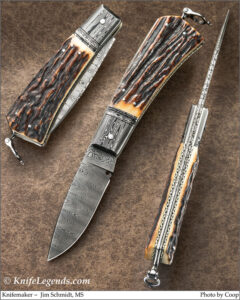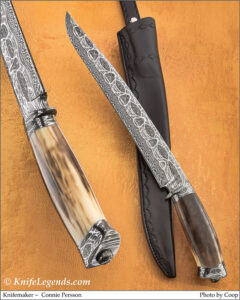Collecting vintage knives is more than just a hobby; it’s a journey into history, craftsmanship, and the artistry of bladesmiths from different eras. For collectors, each knife tells a story—whether it’s a military blade from a bygone war or a meticulously crafted hunting knife passed down through generations. The vintage knife market is vast, with countless styles, materials, and makers to explore. However, buying vintage knives requires knowledge and precision to ensure you’re getting pieces that are both valuable and authentic.
In this collector’s guide, we’ll explore the essentials of buying vintage knives, including what to look for and why working with a reputable dealer like KnifeLegends is critical to building a successful collection.
In order to make sure we are all thinking of the same thing when we discuss Vintage Knives it’s essential to define a few important terms.
Generally speaking, an art knife that is not more than 25 years old is considered Contemporary.
An art knife that is between 25 and 50 years old would be considered Vintage.
An Art Knife between 50 and 75 years old would be considered Semi-antique and an art knife older than 75 years would be considered Antique.
 The Allure of Rare Vintage Knife Collecting
The Allure of Rare Vintage Knife Collecting
The charm of vintage knife collecting lies in the mix of historical significance and aesthetic appeal. Whether it’s the robust designs of military-issued knives or the ornate details of custom hand-forged blades, vintage knives hold a certain mystique. Many collectors are drawn to the craftsmanship of earlier times, when knife makers utilized unique forging techniques and materials, often producing knives that have lasted decades, if not centuries.
For collectors, these knives represent more than their original purpose. They serve as pieces of art, relics of history, and even financial investments. Rare knives can increase in value over time, especially if they’re well-preserved or made by a legendary bladesmith. However, building a collection isn’t just about finding beautiful knives—it’s about understanding their worth, knowing how to evaluate them, and navigating a competitive market.
Tips for Buying Vintage Knives
When entering the vintage knife market, collectors need to be aware of several key factors to ensure they are buying quality pieces. Here’s a step-by-step guide on how to approach buying vintage knives for sale.
1. Understand the Knife’s History
Before buying, familiarize yourself with the history of the knife you’re interested in. Whether it’s a folding pocket knife from the 1800s or a military survival blade, knowing its historical context adds depth to your collection. Do your research on popular vintage knife brands and makers, such as Case, Buck, or Randall. Certain knife styles and manufacturers carry more historical significance and therefore fetch higher prices in the collector’s market.
2. Assess the Condition of the Knife
Condition is paramount when evaluating the value of vintage knives. While some wear is expected, especially for knives that have seen use, excessive damage can drastically reduce a knife’s value. Look for knives that are well-maintained with minimal rust, intact blades, and original handles. Be cautious of knives that have been overly polished or restored, as these modifications can detract from their authenticity and collector’s value.
When buying online, carefully inspect photos and request detailed descriptions. Sellers should provide close-up images of key areas such as the blade edge, handle, and any maker’s marks. Any significant wear, such as deep pitting, broken handles, or excessive sharpening, should be noted.
3. Verify Authenticity
One of the biggest challenges in vintage knife collecting is ensuring authenticity. Counterfeit or replicated knives can sometimes be difficult to spot, particularly for newer collectors. Always check for maker’s marks, stamps, and engravings that confirm the knife’s origin. If possible, research the model number, manufacturing date, and any known variations in design to cross-reference the knife’s details.
When in doubt, consult with experts or purchase from a trusted dealer like KnifeLegends, where authenticity is guaranteed. A knowledgeable dealer will provide accurate provenance and offer knives with well-documented histories.
4. Check the Rarity
Rarity plays a significant role in the value of vintage knives. Some knives were produced in limited quantities, while others might have been custom-made by renowned knife makers. Understanding the rarity of a particular model or maker can help you gauge its value and investment potential.
5. Know the Market Value
Before making a purchase, it’s essential to understand the market value of the knife you’re interested in. Browse through multiple listings and compare prices to ensure you’re not overpaying. Keep in mind that rare or highly sought-after models can fetch premium prices, but it’s important to assess whether the condition justifies the cost.
6. Buy From Reputable Sellers
When buying vintage knives, who you buy from matters. Reputable sellers will stand by the authenticity and quality of their knives, often providing guarantees, certifications, or detailed information about the knife’s origin. KnifeLegends, for example, specializes in rare vintage knives and offers expert advice to ensure you make informed buying decisions.
Avoid buying from unknown sellers or listings with unclear descriptions. Reviews and testimonials from previous buyers can provide insight into a seller’s reliability and reputation.
Why Choosing the Right Dealer Matters
Finding the right vintage knife dealer is one of the most critical steps in building a collection. A knowledgeable and trustworthy dealer can provide you with access to rare and valuable knives, help verify authenticity, and guide you through the nuances of the market. They can also offer insights into a knife’s history, rarity, and long-term investment potential, which can be particularly valuable for novice collectors.
At KnifeLegends, we pride ourselves on offering a curated selection of vintage knives, from historical military blades to rare custom knives. Our expertise and passion for the craft ensure that every knife we sell meets the highest standards of quality and authenticity. Whether you’re just starting your collection or looking to add a rare piece, we are committed to helping you find the perfect knife.
Buying vintage knives can be a rewarding endeavor, but it requires careful consideration, research, and a deep understanding of the market. By following the tips outlined in this guide—researching history, assessing condition, verifying authenticity, and choosing the right seller—you can build a collection that reflects both your passion and your investment goals.
When you’re ready to take the next step in your vintage knife collection, contact KnifeLegends. With our extensive inventory of rare knives and our commitment to quality, we’ll help you find the right piece to enhance your collection.


